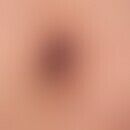Synonym(s)
HistoryThis section has been translated automatically.
DefinitionThis section has been translated automatically.
Gross, circumscribed, plaque or nodular, fibromatous alteration of the tunica albuginea of the corpora cavernosa of the penis.
You might also be interested in
EtiopathogenesisThis section has been translated automatically.
ManifestationThis section has been translated automatically.
LocalizationThis section has been translated automatically.
ClinicThis section has been translated automatically.
Palpable, longitudinal, stripy, plate-shaped or knotty hardenings on the back of the penis. Painful kinking of the penis during erection (>80% of patients), pain (50-70%) as well as in the case of more severe erectile dysfunction (30%) with possible impotentia coeundi.
Side effects: 30% of patients may experience Dupuytren's contracture and keloids or knuckle pads. S.a.u. Polyfibromatosis.
HistologyThis section has been translated automatically.
General therapyThis section has been translated automatically.
The treatment is difficult and often unsatisfactory. A standstill of the disease can be considered a therapeutic success. The course of the disease cannot be estimated, but spontaneous remission is possible (even after years) (approx. 30%).
It is important to inform the patient about the course of the disease. If necessary, psychotherapeutic support should be considered.
Prior to surgery (removal of fibromatous changes), the change should have been clinically halted for 6-9 months (otherwise high recurrence rate).
Progression/forecastThis section has been translated automatically.
TablesThis section has been translated automatically.
Therapeutic approaches in the treatment of induratio penis plastica
Indication |
Example preparations and dosage |
Remarks |
|
Early stages |
Antiphlogistic-externa like glucocorticoids and dexpanthenol cream |
0.1% triamcinolone cream (e.g. triamgals) |
Moderately helpful in initial stages |
0.25% prednicarbate (e.g. Dermatop cream) | |||
5% panthenol cream (Bepanthen) | |||
Intralesional glucocorticoids |
Triamcinolone crystal suspension (e.g. Volon A 1:3 diluted with LA like scandicain) minimum amounts every 3 weeks |
Especially in case of inflammatory changes |
|
X-ray soft X-rays |
GD = 32 Gy, ED = 4 Gy at 8 week intervals |
Especially helpful for pain relief; older, sharp-edged or calcified plaques are no longer accessible to X-ray therapy |
|
|
Late stage (> 45%) |
Operative penis straightening |
e.g. Nespit process or ruffled plastic |
Penis shortening + risk of surgically induced impotence |
Penile prosthesis |
|
ultima ratio |
|
Accompanying to all stadiums over 1-2 years |
Vit. E high dosage |
Vit. E 600-800 mg/day (e.g. Evion) |
No adverse effects, but probably only little beneficial effects |
vitamin A |
Retinol acetate 20 000 IU/day (e.g. retinol) |
||
12 g/day (e.g. Potaba-Glenwood) | |||
Potassium Paraaminobenzoate | |||
LiteratureThis section has been translated automatically.
- Alth G (1984) On the classification of induratio penis plastica (Peyronie's Disease). Vienna Clin Wschr 96: 854-857
- Chen JY et al (2018) Objective Assessments of Peyronie's Disease. Sex Med Rev 6:438-445.
- de la Peyronie F (1743) Sur quelqes obstacles, qui s' opposent à l' éjaculation naturelle de la semence. Mém Acad Chir 1: 425-434
- Meineke V et al (2003) Malignant priapism as a sign of a recurrent prostate cancer. Differential diagnosis of induratio penis plastica. dermatologist 54: 541-543
- Poulsen J et al (1995) Teratment of penile curvature - a retrospective study of 175 patients operated with plication of the tunica albuginea or with the nesbit procedure. Br J Urol 75: 370-374
- Ralph-DJ et al (1995) The nesbit operation for Peyronie's disease: 16 year experience. J Urol 154: 1362-1363
- Ralph DJ et al (2004) The management of Peyronie's disease. BJU Int 93: 208-215
- Rodrigues CI et al (1995) Results of radiotherapy and vitamin E in the treatment of Peyronie's disease. Int J Radiat Oncol Biol Phys 31: 571-576
- Usta MF et al (2004) Relationship Between the Severity of Penile Curvature and the Presence of Comorbidities in Men With Peyronie's Disease. J Urol 171: 775-779
Incoming links (14)
Coronary lymphangitis non-venereal; De-la-peyronie's disease; Dupuytren's contracture; Fibrosal cavernitis; Finger ankle pads real; Impotentia coeundi; Myointimom; Nespit procedure; Penis bones; Peyronie, francois de la; ... Show allOutgoing links (6)
Dupuytren's contracture; Impotentia coeundi; Keloid (overview); Knuckle pads; Polyfibromatosis; Psychotherapy;Disclaimer
Please ask your physician for a reliable diagnosis. This website is only meant as a reference.




